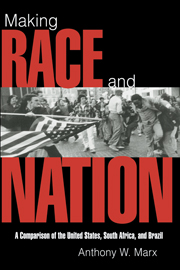Book contents
- Frontmatter
- Contents
- Preface and Acknowledgments
- 1 Introduction
- Part One Historical and Cultural Legacies
- Part Two Racial Domination and the Nation-State
- 5 “We for Thee, South Africa”
- 6 “To Bind Up the Nation's Wounds”
- 7 “Order and Progress”
- Comparative Racial Domination
- Part Three Race Making from Below
- Notes
- Bibliography
- Index
6 - “To Bind Up the Nation's Wounds”
The United States after the Civil War
Published online by Cambridge University Press: 05 June 2012
- Frontmatter
- Contents
- Preface and Acknowledgments
- 1 Introduction
- Part One Historical and Cultural Legacies
- Part Two Racial Domination and the Nation-State
- 5 “We for Thee, South Africa”
- 6 “To Bind Up the Nation's Wounds”
- 7 “Order and Progress”
- Comparative Racial Domination
- Part Three Race Making from Below
- Notes
- Bibliography
- Index
Summary
The U.S. house of race was constructed on a foundation of prejudice. Native Americans were decimated. An elaborate ideology of racial inferiority was gradually applied to Africans, slave and freed, miscegenation and the liberal tradition notwithstanding. This belief in black inferiority became a “self-mlfilling myth that prevented blacks from improving themselves and thereby disproving the image that whites had of them.” Though such discrimination was pervasive, the American house of race was really two separate structures under one roof of a common Constitution. The agrarian South insisted on continued slavery, resisted by the North. To form a single republic, slavery concentrated in the South was allowed to continue, while the North took the lead in early segregation. Given continued regional tension over slavery, state unification was itself circumscribed. A weak central authority coordinated states retaining all powers not delegated to the center, including many of those regarding slavery. The genius of federalism was that providing for the rights of states or regions to construct their own social order preserved a loose confederation of those states, avoiding conflict. These arrangements reinforced the fault line running along the Mason-Dixon line and accommodated in the Constitution's federalism.
The Nation Divided
The United States at mid-nineteenth century was torn by regional strife comparable to the ethnic conflict later culminating in the creation of South Africa.
- Type
- Chapter
- Information
- Making Race and NationA Comparison of South Africa, the United States, and Brazil, pp. 120 - 157Publisher: Cambridge University PressPrint publication year: 1997

